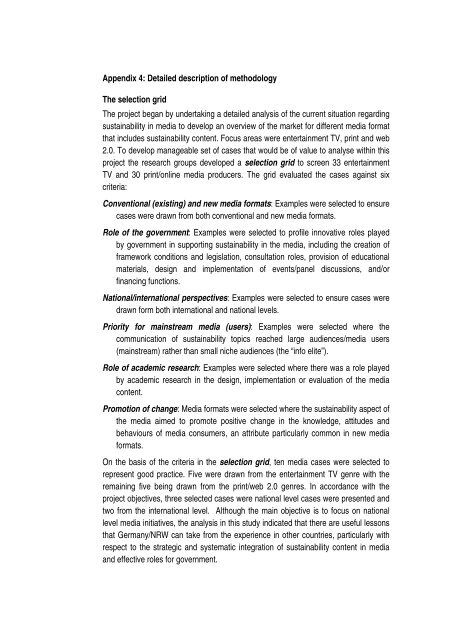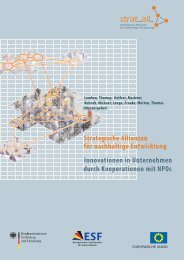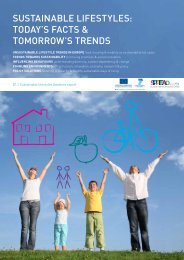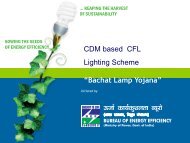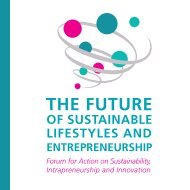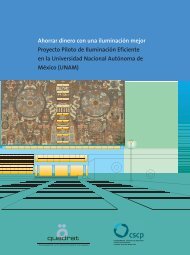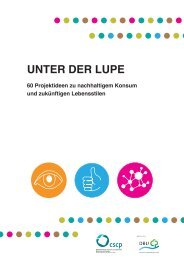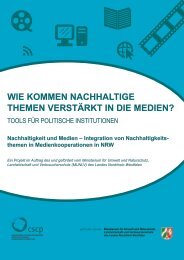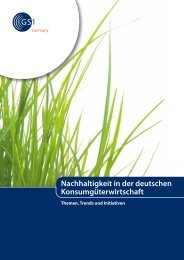integrating sustainability themes into media - Collaborating Centre ...
integrating sustainability themes into media - Collaborating Centre ...
integrating sustainability themes into media - Collaborating Centre ...
You also want an ePaper? Increase the reach of your titles
YUMPU automatically turns print PDFs into web optimized ePapers that Google loves.
www.triple-innova.com<br />
Appendix 4: Detailed description of methodology<br />
The selection grid<br />
The project began by undertaking a detailed analysis of the current situation regarding<br />
<strong>sustainability</strong> in <strong>media</strong> to develop an overview of the market for different <strong>media</strong> format<br />
that includes <strong>sustainability</strong> content. Focus areas were entertainment TV, print and web<br />
2.0. To develop manageable set of cases that would be of value to analyse within this<br />
project the research groups developed a selection grid to screen 33 entertainment<br />
TV and 30 print/online <strong>media</strong> producers. The grid evaluated the cases against six<br />
criteria:<br />
Conventional (existing) and new <strong>media</strong> formats: Examples were selected to ensure<br />
cases were drawn from both conventional and new <strong>media</strong> formats.<br />
Role of the government: Examples were selected to profile innovative roles played<br />
by government in supporting <strong>sustainability</strong> in the <strong>media</strong>, including the creation of<br />
framework conditions and legislation, consultation roles, provision of educational<br />
materials, design and implementation of events/panel discussions, and/or<br />
financing functions.<br />
National/international perspectives: Examples were selected to ensure cases were<br />
drawn form both international and national levels.<br />
Priority for mainstream <strong>media</strong> (users): Examples were selected where the<br />
communication of <strong>sustainability</strong> topics reached large audiences/<strong>media</strong> users<br />
(mainstream) rather than small niche audiences (the “info elite”).<br />
Role of academic research: Examples were selected where there was a role played<br />
by academic research in the design, implementation or evaluation of the <strong>media</strong><br />
content.<br />
Promotion of change: Media formats were selected where the <strong>sustainability</strong> aspect of<br />
the <strong>media</strong> aimed to promote positive change in the knowledge, attitudes and<br />
behaviours of <strong>media</strong> consumers, an attribute particularly common in new <strong>media</strong><br />
formats.<br />
On the basis of the criteria in the selection grid, ten <strong>media</strong> cases were selected to<br />
represent good practice. Five were drawn from the entertainment TV genre with the<br />
remaining five being drawn from the print/web 2.0 genres. In accordance with the<br />
project objectives, three selected cases were national level cases were presented and<br />
two from the international level. Although the main objective is to focus on national<br />
level <strong>media</strong> initiatives, the analysis in this study indicated that there are useful lessons<br />
that Germany/NRW can take from the experience in other countries, particularly with<br />
respect to the strategic and systematic integration of <strong>sustainability</strong> content in <strong>media</strong><br />
and effective roles for government.


